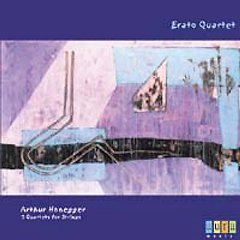Honegger – String Quartets; Cello Concerto (2000)
Honegger – String Quartets; Cello Concerto (2000)

String Quartet No. 1 in C minor, H. 152 I. Appassionato II. Adagio III. Allegro String Quartet No. 2 in D major, H. 103 I. Allegro II. Adagio III. Allegro marcato String Quartet No. 3 in E major, H. 114 I. Allegro II. Adagio III. Allegro + Cello Concerto in C major, H. 72 I. Andante II. Lento III. Allegro marcato Erato String Quartet Mstislav Rostropovich (Cello) London Symphony Orchestra Kent Nagano (Conductor)
Established foremost in the musical community for his orchestral, symphonic and vocal/oratorio output, it seems hardly surprising, then, that these three string quartets of Arthur Honegger (1892-1955) have been notoriously neglected. Triggering this neglect might be the fact that Honegger chose to write very few chamber works, rather disengaging from the form to concentrate on larger venues.
That said, I must admit that the composer might have done himself, and us, a disservice. As the crux of his chamber output, the three extant quartets are infinitely fascinating and formidable, each tempered by the extraordinary use of an ever-evolving musical vocabulary.
The earliest, Quartet for Strings No. 1 (1917), already shows Honegger's penchant for balancing dissonance, chromaticism and melody in a way that creates a delightful frisson. Case-in-point: The juxtapositioning of the very Faure-like opening Appassionato and the second movement Adagio, with its solemn cello recitative and continuous lyrical string meanderings. There is an appealing and overt romanticism here not found in the quartets that follow two decades later.
Quartet for Strings No.'s 2 (1936) and 3 (1937) are more distinctly modernistic, the allegros propulsive and discordant, thematic material veering sharply away from melodic involvement. Here we enter the mainstreams of Bartok, Prokofiev and Shostakovich. Remarkable, however, are the somber and thought-provoking adagio movements that form the true compositional cores.
Performed with the kind of simpatico and idiomatic panache necessary to reveal these "Beethovenian underproducts," as Honegger called his three quartets, to the fullest possible measure, the Erato ensemble succeeds completely. The sound they produce has been captured intimately and beautifully. ---Melvyn M. Sobel, amazon.com
Of the three concertante works that Honegger composed, this is the only one without a diminutive in the title. Ironically, it is one of Honegger's most light-hearted, even amusing scores. Considering that it is written in Honegger's most 'popular' style, its' neglect is incomprehensible.
It is tuneful and rhythmically vital.The soloist is given dramatic moments and showy displays. He croons some lovely melodies, sings a swinging little ditty, declaims passionately, but always maintains dignity. Honegger's writing for string instruments tended to be rather conservative. There is hardly a harmonic sounded nor a pizzicato plucked. The orchestration is transparent yet full blooded. The use of muted brass emphasizes the frequent hints of jazz sonorities.
The balance between soloist and orchestra, always a problem in the Cello Concerto, is achieved by means of having more dialogue than argument between the participants. This also increases the geniality of the music, which does not wrestle with larger philosophical questions as is often the case in Honegger's music. In places like the jazzy middle section of the work, Honegger gives the cello a stately melody while the orchestra interjects comments of an almost comical nature.
After World War I, Honegger was a member of "Les Six" a group whose spokesman Jean Cocteau called for a return to the French music hall and away from the dominance of Richard Wagner's music. Honegger rarely followed that edict, but in this concerto he does allow the influences of the music hall to be heard.
It is so concise that the listener might easily regret that the Concerto doesn't last much longer.
Composed in 1929, it was premiered by, and dedicated to Maurice Marechal. Serge Koussevitzky led the Boston Symphony Orchestra. ---Eric Goldberg, Rovi
download: uploaded filecloudio anonfiles yandex 4shared solidfiles mediafire mega nornar
Last Updated (Saturday, 11 January 2014 13:17)








